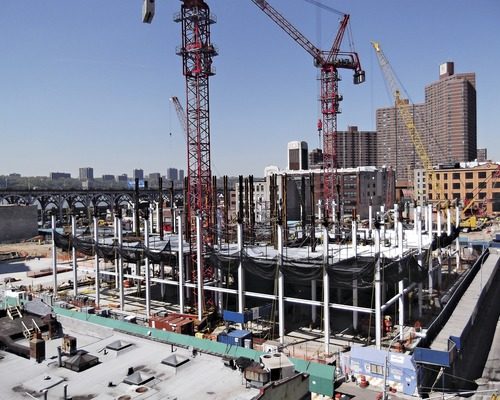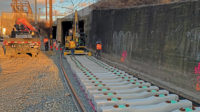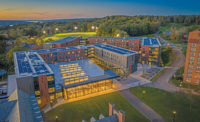Up, Down, Side to Side: Columbia's New Campus Rumbles to Life






"One of the challenges … Columbia addressed very well was [how] they committed to very long-term goals for this campus," says Nico Kienzl, director for Atelier Ten, environmental design consultant on the project.
The new buildings also bolster Manhattanville's sustainability profile with an automatic interior shade system and natural lighting for many of the 60 labs in Greene and key spaces in Lenfest, such as its multipurpose rehearsal room and theater, Chaaya says.
The buildings also feature chilled beams, radiant heat on building perimeters, low-flow water fixtures, high-efficiency wastewater pumps and a reflective roof, Pitruzzello says.
The double-skin facade on sections of both Greene and Lenfest—widely used in Europe but seldom in the U.S.— is another prominent feature. The system pushes low-velocity air between two laminated glass panels, creating a layer of insulation. For Greene's labs and Lenfest's theater, the system muffles noise, Chaaya says.
"We had to deal with some acoustic mitigation," he says, citing a need to cut the subway's 88 decibels down to 44. "This challenge you cannot accommodate with a conventional facade."
It also serves as a barrier for extreme temperature by having cold air circulate through the facade in summer and warm air in winter.
The buildings use triple-pane glazing on other parts of the facade where sound and solar heat are less troublesome, Kienzl says. "We have a very differentiated facade for different orientations," he adds. "That was a really complex but fun piece to work on … a productive collaboration."
Clean Construction
Another big sustainable push was reducing the impact of dust, noise, waste, emissions and even rodents from the site.
An 11-ft-high perimeter fence, angled inward and covered with sound blankets around construction zones, muffles the onsite din, while self-adjusting truck backup alarms modulate warning beeps to the ambient noise level, Sommer says. To control dust and emissions, the team has installed diesel particulate filters on all equipment, employs wheel and under-chassis washers on all trucks leaving the site and strives to use electric equipment instead of diesel, he says.











